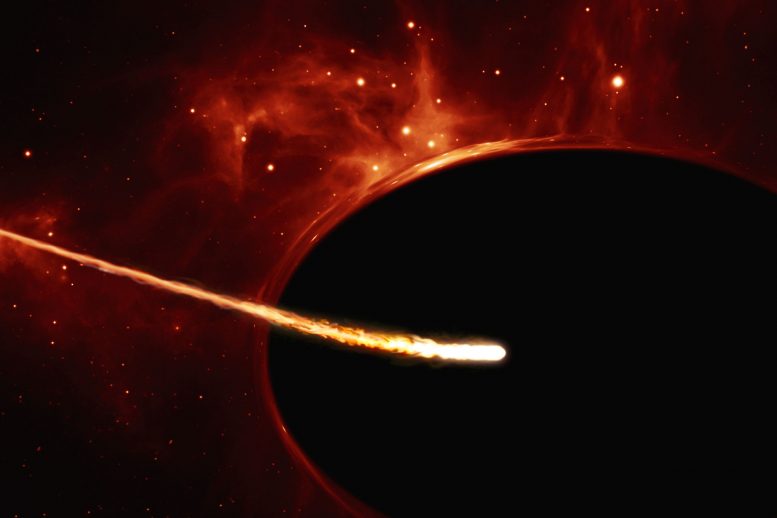
This artist’s impression depicts a Sun-like star close to a rapidly spinning supermassive black hole, with a mass of about 100 million times the mass of the Sun, in the center of a distant galaxy. Its large mass bends the light from stars and gas behind it. Despite being way more massive than the star, the supermassive black hole has an event horizon which is only 200 times larger than the size of the star. Its fast rotation has changed its shape into an oblate sphere. The gravitational pull of the supermassive black hole rips the star apart in a tidal disruption event. In the process, the star was “spaghettified” and shocks in the colliding debris as well as heat generated in accretion led to a burst of light.
Using the Hubble Space Telescope, astronomers reveal a rapidly spinning black hole ripping apart a passing star that came too close.
An extraordinarily brilliant point of light seen in a distant galaxy, dubbed ASASSN-15lh, was thought to be the brightest supernova ever seen. But new observations from several observatories, including the NASA/ESA Hubble Space Telescope, have now cast doubt on this classification. Instead, a group of astronomers propose that the source was an even more extreme and rare event — a rapidly spinning black hole ripping apart a passing star that came too close.
In 2015, the All Sky Automated Survey for SuperNovae (ASAS-SN) detected an event, named ASASSN-15lh, that was recorded as the brightest supernova ever — and categorized as a superluminous supernova, the explosion of an extremely massive star at the end of its life. It was twice as bright as the previous record holder, and at its peak was 20 times brighter than the total light output of the entire Milky Way.
An international team, led by Giorgos Leloudas at the Weizmann Institute of Science, Israel, and the Dark Cosmology Center, Denmark, has now made additional observations of the distant galaxy, about 4 billion light-years from Earth, where the explosion took place and they have proposed a new explanation for this extraordinary event.
“We observed the source for 10 months following the event and have concluded that the explanation is unlikely to lie with an extraordinary bright supernova. Our results indicate that the event was probably caused by a rapidly spinning supermassive black hole as it destroyed a low-mass star,” explains Leloudas.
In this scenario, the extreme gravitational forces of a supermassive black hole, located in the center of the host galaxy, ripped apart a Sun-like star that wandered too close — a so-called tidal disruption event, something so far only observed about 10 times. In the process, the star was “spaghettified” and shocks in the colliding debris as well as heat generated in accretion led to a burst of light. This gave the event the appearance of a very bright supernova explosion, even though the star would not have become a supernova on its own as it did not have enough mass.
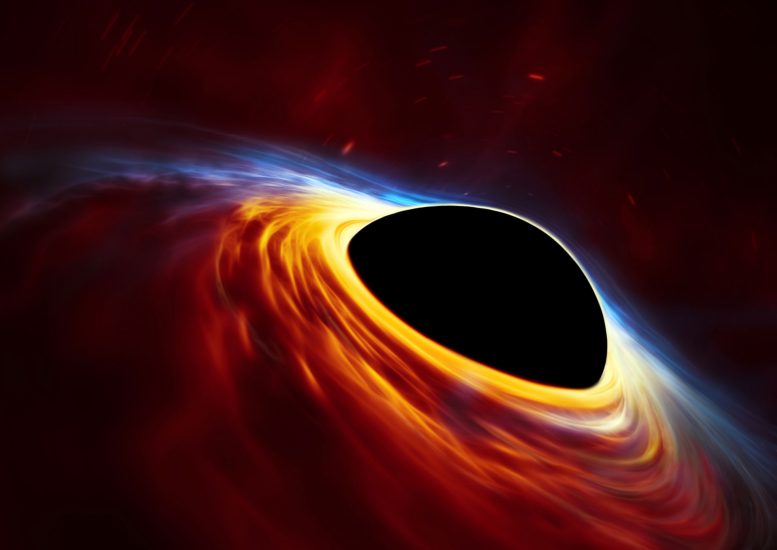
This artist’s impression depicts a rapidly spinning supermassive black hole surrounded by an accretion disc. This thin disc of rotating material consists of the leftovers of a Sun-like star which was ripped apart by the tidal forces of the black hole. Shocks in the colliding debris as well as heat generated in accretion led to a burst of light, resembling a supernova explosion.
The team based their new conclusions on observations from a selection of telescopes, both on the ground and in space. Among them were the NASA/ESA Hubble Space Telescope, the Very Large Telescope at ESO’s Paranal Observatory, and the New Technology Telescope at ESO’s La Silla Observatory.
“There are several independent aspects to the observations that suggest that this event was indeed a tidal disruption and not a superluminous supernova,” explains coauthor Morgan Fraser from the University of Cambridge, UK (now at University College Dublin, Ireland).
In particular, the data revealed that the event went through three distinct phases over the 10 months of follow-up observations. These data overall more closely resemble what is expected for a tidal disruption than a superluminous supernova. An observed re-brightening in ultraviolet light as well as a temperature increase further reduce the likelihood of a supernova event. Furthermore, the location of the event — a red, massive, and passive galaxy — is not the usual home for a superluminous supernova explosion, which normally occur in blue, star-forming dwarf galaxies.
Although the team says a supernova source is therefore very unlikely, they accept that a classical tidal disruption event would not be an adequate explanation for the event either. Team member Nicholas Stone from Columbia University, USA, elaborates: “The tidal disruption event we propose cannot be explained with a non-spinning supermassive black hole. We argue that ASASSN-15lh was a tidal disruption event arising from a very particular kind of black hole.”
The mass of the host galaxy implies that the supermassive black hole at its center has a mass of at least 100 million times that of the Sun. A black hole of this mass would normally be unable to disrupt stars outside of its event horizon — the boundary within which nothing is able to escape its gravitational pull. However, if the black hole is a particular kind that happens to be rapidly spinning — a so-called Kerr black hole — the situation changes and this limit no longer applies.
“Even with all the collected data we cannot say with 100% certainty that the ASASSN-15lh event was a tidal disruption event,” concludes Leloudas. “But it is by far the most likely explanation.”
This animation shows how the ASASSN-15lh most likely happened. A Sun-like star gets into the area of influence of a rapidly spinning supermassive black hole in the center of a distant galaxy. While its orbit gets constantly closer to the black hole the star gets “spaghettified”, creating an accretion disc around the supermassive black hole. When it finally gets ripped apart close to the event horizon it creates a bright flash, that could resemble a superluminous supernova.
Reference: “The Superluminous Transient ASASSN-15lh as a Tidal Disruption Event from a Kerr Black Hole” by G. Leloudas, M. Fraser, N. C. Stone, S. van Velzen, P. G. Jonker, I. Arcavi, C. Fremling, J. R. Maund, S. J. Smartt, T. Kruhler, J. C. A. Miller-Jones, P. M. Vreeswijk, A. Gal-Yam, P. A. Mazzali, A. De Cia, D. A. Howell, C. Inserra, F. Patat, A. de Ugarte Postigo, O. Yaron, C. Ashall, I. Bar, H. Campbell, T.-W. Chen, M. Childress, N. Elias-Rosa, J. Harmanen, G. Hosseinzadeh, J. Johansson, T. Kangas, E. Kankare, S. Kim, H. Kuncarayakti, J. Lyman, M. R. Magee, K. Maguire, D. Malesani, S. Mattila, C. V. McCully, M. Nicholl, S. Prentice, C. Romero-Canizales, S. Schulze, K. W. Smith, J. Sollerman, M. Sullivan, B. E. Tucker, S. Valenti, J. C. Wheeler and D. R. Young, 12 December 2016, Nature Astronomy.
DOI: 10.1038/s41550-016-0002
arXiv: 1609.02927
This simulation shows a star getting torn apart by the gravitational tides of a supermassive black hole. The star gets “spaghettified” and after several orbits creates an accretion disc. Scientists believe that the superluminous ASASSN-15lh event happened like that.

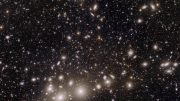
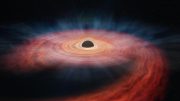

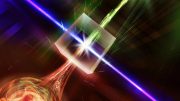

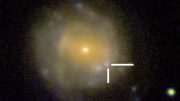

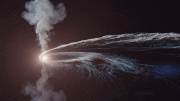
Simulation, animation, artist’s depiction, impression…
What are you all trying to pull here?
Spaghettification? Blackhole? Wormhole? Flying Spaghetti Monster? Why all these unscientific names? Are these all fiction turned science with fake manufactured data?
If there wasn’t a god would it be necessary to invent it? (Voltaire)
What are darkvoids made of? Pixy dust?
Looking through a telescope must me like looking through a blackhole. Stars eat each other. Yes. Galactic Star incorporates other nearby stars, thats likely one way they get so big. You don’t have to be an asstronomer to make beLIEve in blackholes.
I mean you do have to be an asstronomer to beLIEve in these.
Sorry but Science an isolated process; if lies go on in politics and religion, it’s logical to assume they happen in Science also especially when they depend on funding and or black budgets. Sadly. Anyways, I am not convinced.
Blackhole? More like Whitelies.
Sorry for not being serious and rude with the word asstronomer.
I dislike lies in general: white, black, brown, yellow, red, green, grey or other.
How many asstronomers does it take for their collective aggregate imagination to become knowledge? Depends on how singular they are.
Oh, touches on Science fascism.
But seriously and logically, I say if one’s doing conspiracy theories/hypothesises, they must not be part of the conspiracy.
Sorry for saying ‘asstronomer’ and trying to be funny. No offence intended to the profession. I’m kind of offended by this blackhole peddling with mostly art & theory instead of observation & clear explanation. Stars merge if they come too close together. Right?
I’m really really sorry for saying asstronomer; I appreciate the Science of Astronomy a the people/scientists working as astronomers.
I’m just kind of upset with this ‘blackhole’ word and what it signifies and the apparent lack of observation. Once you start using animations, depictions and simulations instead of actual observation it’s difficult to regain trust as scientists.
The whole concept doesn’t make sense. Hypothesising these objects exists, then hypothesising they are made of dark matter and so on and on. Seems like a runaway train. Just observe and describe.
I’m sorry for being an amateur and possibly ignorant. Sorry for being disrespectful of astronomers also. But this word and concept seems senseless. Why even came up with the idea of dark matter? I just hope to ‘god’ all this isn’t sexist or racialist because that will be an even bigger stain on Science (which to some is in competition with religion) with regard to ethics and social policy.